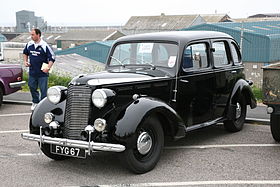Vauxhall 14-6
| Vauxhall 14-6 | |
|---|---|
 Vauxhall Fourteen-Six 1938-1948 unitary hulled six-light saloon 1947 example | |
| Overview | |
| Manufacturer | Vauxhall |
| Also called | Vauxhall Fourteen-Six Vauxhall Model J |
| Production | 1939 to 1948 |
| Assembly | England Australia |
| Body and chassis | |
| Body style | 4-door saloon 2-door coupé (Australia) 2-door roadster (Australia) 2-door coupé utility (Australia) 2-door roadster utility (Australia) |
| Layout | FR layout |
| Related | Bedford JC |
| Powertrain | |
| Engine | 1,781cc I6 |
| Dimensions | |
| Wheelbase | 105 in (2,700 mm) |
| Length | 168 in (4,300 mm) |
| Width | 63.5 in (1,610 mm) |
| Curb weight | 22.5 cwt |
| Chronology | |
| Predecessor | Vauxhall Light Six |
| Successor | Vauxhall Velox |
The Vauxhall 14-6 is an automobile produced by Vauxhall in England from 1939 until 1948.
Announced in October 1938 for the 1938 British International Motor Show at Earls Court, the 14-6 was offered as a six-light, four door saloon and was powered by a four bearing, OHV, 1,781cc Straight-six engine.[1][2] It had a top speed of 70 mph and could accelerate from 0-50 mph in 18.2 seconds.[3]
Engine, transmission and suspension[edit]
The previous engine was retained but with compression ratio raised from 6.25 to 6.75:1 and revised timing increasing the output to 48 bhp at 3000rpm.[3] Other features included independent front suspension using torsion bars in place of the previous Dubonnet system with semi-elliptic leaf springs at the rear, Lockheed hydraulic brakes and a three-speed all-synchromesh gearbox in place of the four-speed "silent third" gearbox.[2]
Unitary chassis-body[edit]
The car now had a unitary hull which had a 4 in (100 mm) longer wheelbase and 1 in (25 mm) wider track than its predecessor which made it larger than the 12-4 model announced at the same time. Previously the 12 and 14 hp models had shared the same body. Interior features included individual leather front seats and a rear seat with fold-down arm rest, a rear window blind and a sliding sunroof.
Post World War II models can be distinguished by bonnet-louvre and grille changes.[4] A total of 45,499 were produced, including 30,511 in the post war period.[2][4]
Australian production[edit]
A Vauxhall 14 J was built by Holden in Australia without unitary construction[5] which was beyond the capacity of local presses but sharing much of the English car's styling.[6][7] The separate chassis allowed the Australian firm to provide open and utility bodies. Commencing in 1939, the 14 was offered in sedan, coupé and roadster body-styles.[8] and as in England but in a Holden version, a light utility.[9]
A 14 sedan was the first civilian car to be produced by Holden in the post war period, leaving the Fishermans Bend assembly line on 21 May 1946.[8]
-
Vauxhall drophead coupé 1939
-
Bedford Business Roadster or coupé utility 1940
-
Vauxhall 14 Model J 1946
note Holden's divided windscreen and roof
References[edit]
- ^ Cars Of 1939, Vauxhall 14 changes The Times 6 October 1938 page 17
- ^ a b c Gillies, Mark; Sedgwick, Michael (1993). A-Z of Cars of the 1930s. Haymarket Publishing. p. 208. ISBN 9781870979023.
- ^ a b Culshaw; Horrobin (1974). Complete Catalogue of British Cars. London: Macmillan Publishers. ISBN 978-0-333-16689-5.
- ^ a b Gillies, Mark; Sedgwick, Michael (1994). A-Z of Cars 1945-1970. Haymarket Publishing. p. 212. ISBN 9780600333913.
- ^ Improved bodies for Vauxhall 14 Truth 4 June 1939 page 12
- ^ Darwin, Norm (1983). The History of Holden since 1917. Ford Publications. pp. 87–89. ISBN 9780959228700.
- ^ Vauxhall 14 Sydney Morning Herald '2 May 1939 page 6
- ^ a b Darwin, Norm (2002). 100 Years of GM in Australia. pp. 130–133. ISBN 9780646414768.
- ^ Striking gains in latest Vauxhall product The Sun 2 May 1939 page 14
External links[edit]
![]() Media related to Vauxhall 14 at Wikimedia Commons
Media related to Vauxhall 14 at Wikimedia Commons



